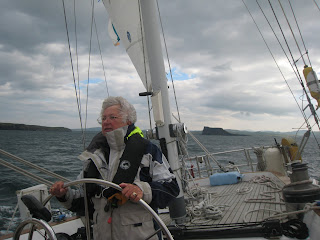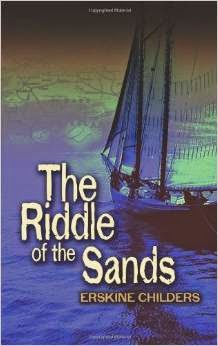 |
| Catabatic winds blowing down Skye as we depart |
The day of the winds

It was heavily overcast, but a nice breeze of 10-15 knots as
promised, as we prepared to get underway. We hoisted the main and mizzen and
made way by 0830, heading down the Loch Harport with the tide but directly into
the wind. As we turned the last corner
by the light house where we thought we’d be sailing, the wind started cranking
up really fast: 20, 23, 25, 27, 29, 33.
Oh my, the boat ahead of us in full sail was getting hammered. Suddenly, it was slammed to the water,
broaching as it rounded up.
 |
| Alex puts two reefs in the mainsail |
Aleria is not as easy a pushover, but seeing that, Alex
quickly went forward and double reefed the main as the wind stabilized at
around 27 knots. The boat ahead of us did the same. We suspected katabatic
winds, and so we power sailed through it, mostly on the nose. It suddenly dropped from 27 knots to 17, and
we were sailing along quite nicely with Skye behind us whipping up our wake. A katabatic wind originates from cooling of
air atop a plateau, a mountain, glacier, or even a hill. Since the density of air is
inversely proportional to temperature, the air flows downwards,
warming as it descends, thereby increasing the speed of the wind.
These mountains are known for their incessant winds. And Skye made sure we had
a taste of Scotland’s true nature.
 |
| Onyx and Alex discussing options |
As we sailed around the Small Isles in the blessed silence of wind but no engine, the wind died. We motor sailed the remaining 6 miles to Coll,
our intended destination, once again in brilliant hot sunshine, calm seas, but
a big gentle ocean swell. There had to
be a storm somewhere out there to be creating a swell like that. On approach to Coll, we realized the anchorage
was exposed to the south and east, the direction from which the swell emanated.
It would be a mighty uncomfortable anchorage for the night, and if the weather
was coming from that direction, it might not be very secure either.
I quickly scouted out alternative anchorages and decided
on Loch Tuath on Gometra. I liked the
sound of the name, which I thought must have something to do with the mythical
celtic gods, the Tuatha de Dannan. These
gods, who originally lived on 'the islands in the west', had perfected the use
of magic. They travelled on a big cloud to the land that later would be called
Ireland and settled there. Then again,
Tuath means people, so perhaps it is just the lake of the people.
 |
| Squall hits as we approach Mull |
Loch Tuath separates the Isle of Mull from Ulva and Gometra;
we had anchored on the other side between Ulva and Gometra a few days before
and it was beautiful. We thought this
held as much promise and certainly looked like a much more secure anchorage. And Soriby Bay at its head, nestled into Ulva,
looked most promising.
As we approached, a squall came through with 25 knots
sustained, whipping up the ocean around us.
We were screaming along. We were
hoping that once inside we’d find some shelter from this kind of squall, which
was increasingly common in this now unstable air mass of hot humid air. You could see the angry anvils forming all
around. We needed good shelter and good
holding. Getting the main down in this
kind of squall would be a chore at best.
Meanwhile we were sailing at high speed to windward into the loch, but
the winds were not abating.
 |
| Interesting sky again |
We noticed an anchorage that looked like a tiny canyon in
the wall of Gometra with at least two boats in it. Then we noticed another boat
tucked in between Gometra and Ulva, but neither of these looked like a good
choice in this weather.
A small catamaran, it looked like a James Wharram design with two Polynesian styled-hulls, appeared out of nowhere and
was heading in as well. It seemed to be doing quite nicely in this wind,
screaming along almost as fast as we were. That’s amazing as it was about half our hull length.
And it was being single-handed.
 |
| Squall behind us as we move up the loch |
When we got in to Soriby Bay at the head of the loch, it was
like a door had closed behind us on the squall. The water was smooth, the high hills around us
calming the wind to about 15 knots. There was one boat anchored in the prime
spot that we had selected on the chart – damn! There were salmon cages along
the rocks to the right, which were covered in seals. We dropped the sails, dropped the hook, tidied
up the ropes, and celebrated with a dram of Scotch – Talisker. We had lovely views, a protected cove, and we
were happy.
Meanwhile, the catamaran, came in shortly after us with four
people now on deck and anchored right next to the original boat in the harbour
while the skipper glared at them with anger.
They were both British flagged vessels so we thought we’d let them
settle things directly. But everyone settled down and went below shortly
thereafter, while we enjoyed the evening listening once again to the wailing of
the seals. These seals were as talkative
as the ones on Lunga, and these guys kept talking all through the night.
 |
| Reading in between squalls and off watch |
 |
| Writing notes about today's story |
 |
| The anchorage in Soriby Bay, in Loch Tuath |
 |
| Fish farm and seal rocks on Ulva |
 |
| Anchorage on Gometra |
 |
| Gap between Gometra and Ulva. Boat anchored to the left. |

 It was heavily overcast, but a nice breeze of 10-15 knots as
promised, as we prepared to get underway. We hoisted the main and mizzen and
made way by 0830, heading down the Loch Harport with the tide but directly into
the wind. As we turned the last corner
by the light house where we thought we’d be sailing, the wind started cranking
up really fast: 20, 23, 25, 27, 29, 33.
Oh my, the boat ahead of us in full sail was getting hammered. Suddenly, it was slammed to the water,
broaching as it rounded up.
It was heavily overcast, but a nice breeze of 10-15 knots as
promised, as we prepared to get underway. We hoisted the main and mizzen and
made way by 0830, heading down the Loch Harport with the tide but directly into
the wind. As we turned the last corner
by the light house where we thought we’d be sailing, the wind started cranking
up really fast: 20, 23, 25, 27, 29, 33.
Oh my, the boat ahead of us in full sail was getting hammered. Suddenly, it was slammed to the water,
broaching as it rounded up. 













Comments
Post a Comment